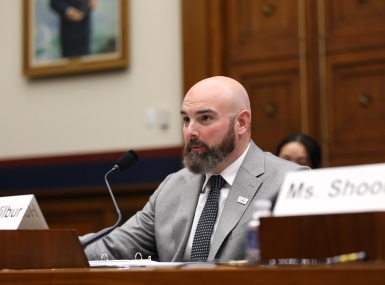The baby boomers are coming — Is your county ready?

Key Takeaways
If you remember using a pay phone, a typewriter or listening to music on a record player, you’re likely a member of the baby boomer generation.
This unusually large generation is living longer, in better health and working longer — and because of that, they’re looking for meaning, new careers and new experiences. About 10,000 baby boomers — those born between 1946 and 1964 — turn 65 each day. About 26 million of them began hitting retirement age about 10 years ago and another 50 million will turn 65 in the next 10 years.
By the year 2026, 17 states will be in what Fitch Ratings calls a “super aged” category, meaning at least 20 percent of their populations will be 65 or older. And by 2030, all baby boomers will be older than 65, expanding the size of the older population so that one in every five residents will be retirement age.
Learn More
Some local governments vie for attention of retiring baby boomers
Frederick County, Md.'s recommendations for improvements for seniors
“The aging of baby boomers means that within just a couple decades, older people are projected to outnumber children for the first time in U.S. history,” said Jonathan Vespa, a demographer with the U.S. Census Bureau.
As the baby boomers age and retire, what impact will they have on counties?
When it comes to an aging population, for starters you’re likely see a rise in health care costs and tax subsidies in your county, said Frank Shafroth, director for State and Local Government Leadership at George Mason University in Fairfax County, Va.
Medicaid is the second largest budget item for states behind education and counties will have to bear more of the costs as costs rise for the states.
“Counties, far more than cities, provide health care — and with Americans living longer (about 50 years ago, the average life expectancy was 70.9; today it’s 77.9) than previous generations, retirement health care is almost certain to consume a greater portion of county budgets,” Shafroth said.
Counties invest approximately $83 billion annually in community health and hospitals, and about $28 billion to the non-federal share of Medicaid, NACo research shows.
While health care for senior residents could put a strain on county budgets, other considerations include things like capped home assessments and other tax breaks for seniors, according to Shafroth. Property taxes account for about 35 percent of local revenue.
Limiting property tax assessments crimps county budgets, Shafroth said. “Any limitations on one of the most critical sources of county income — property taxes — especially coming in an aging America, could put many counties between a rock and a hard place.”
County residents in Illinois will help make up a gap for baby boomers who account for 52 percent of the 3.2 million owner-occupied homes in the state. That’s because senior citizens’ home assessments are capped, and they pay taxes only on that frozen amount until they move from the home. In 2015, those exemptions accounted for $6.5 billion in home values being transferred to other residents, according to the state department of revenue.
“This is a big chunk of the population and they’re going to live longer,” said Carol Portman, president of the Taxpayers Federation of Illinois. “The dollar cost to everyone else in some of these instances is going to grow in ways that likely weren’t anticipated when each one of these breaks were added individually.”
In California, voters gave a thumbs down Nov. 6 on Proposition 5, which would have allowed homeowners age 55 and older to receive a tax break when they move.
The California State Association of Counties (CSAC) opposed the measure. “What the real estate industry is really trying to do with this measure is turn over the market and drive up prices so their end profit is really to their benefit,” said Dorothy Johnson, CSAC legislative representative. CSAC argues that it would have permanently eroded the property tax base and result in county losses totaling hundreds of millions of dollars statewide, growing to $1 billion annually for local governments and an additional $1 billion loss for schools. The California Legislative Analyst’s Office concluded that Prop. 5 would eventually cost local governments $2 billion a year in revenue.
On top of reduced property taxes, a county with a large senior population could see more demand on county services such as 911 calls, ambulances and hospitals, addressing dementia as a public safety responsibility and adopting programs for dealing with loneliness.
In addition to services geared to medical and healthcare issues, counties must also look at recreation and service opportunities for healthy boomers.
These are all some of the issues that Kathy Schey deals with on a daily basis, as the head of Frederick County, Md.’s new Division of Senior Services, which got off the ground earlier this year. The county released a report in 2016, which took a year to prepare from surveys and community focus groups, that made 33 recommendations for improvements in services for seniors. (See the report at: https://bit.ly/2PgBAUH.)
The report highlighted the need for a new division to address the needs of the county’s exploding senior population, expected to grow at a rate three times that of the overall population and exceed the number of school-aged children by 2020, according to the Maryland Department of Planning.
The division’s departments will include:
- Home and Community Connections, which promotes aging in place, remaining healthy, active and in the community
- Life Enrichment, which promotes education, civic and social engagement, recreation and fitness, and
- Operations, which fuels the entire division
“Our goal is to empower, engage and equip each individual, meeting them at their point of need, interest or ability,” Schey said. In addition to the 2016 report, the county is also using a 2013 needs assessment that identified several major areas the county needs to work on, including:
- Accessible and affordable housing
- Transportation
- Long term services and supports
- Opportunity for health
- Social and Civic Engagement
- Economic and workforce development, and
- Communications, outreach and collaboration.
“Of special interest is the collaboration of the Senior Services Division and Frederick County TransIT to address the transportation needs,” Schey said. “This is particularly important as our county is the largest geographic county in the state of Maryland.”
“We know that Frederick County seniors want more transportation options, from walkable communities to public transit,” she noted. “In addition to fixed route and rural shuttle service, our County TransIT Services provide paratransit service for seniors and people with disabilities. This paratransit service is a lifeline for seniors with no other way to get to medical and other appointments.”
Seniors can call or book their trip online, and TransIT will send a driver to pick them up and take them to their destination. There is no federal funding for the program (compared to 50 percent federal funding contribution to fixed route or rural services). State funding has been flat at only $159,159 for well over 10 years, and the county contributes more than $500,000, she said.
“With the fast-paced growth of our senior population, TransIT has been inundated with trip requests, more than there are resources to fill,” she said. “As a result, citizens are sometimes unable to access this vital transportation. This is an area that needs attention, as transportation is the gateway to accessing healthcare, socialization, and connection to the community.”
Some local governments vie for attention of retiring baby boomers
It’s a demographic some local governments are courting. Fueled by dollars from both Leon County, Fla., and Tallahassee, Fla., “Choose Tallahassee” is going out of its way to recruit baby boomers as residents. Headed up by an executive director and with help from a cadre of volunteers, the entity bought ads with the tagline “Things Aren’t the Same Since You Left” aimed at baby boomers who have left the area, gone to college there or once worked in the area. Ads are targeted at parents enticing them to recruit their parents living elsewhere, showcasing advantages such as free babysitting. Other ads are targeted to boomers, touting free tech support and handyman services from their offspring.
Choose Tallahassee even held a contest offering a year of free housing and other perks. The winners, two retired teachers who had planned to move back to their hometown in Alabama, said Tallahassee had many of the perks they were looking for such as college football, plays, musicals and lifelong learning for people over 50. Meanwhile about 10 communities catering to the older crowd — with swimming pools and golf courses — are under construction.
Boomers spend a lot. They’re a demographic whose annual economic activity is roughly $7.6 trillion, according to AARP. As of 2013, Americans over the age of 50 represent the third-largest economy in the world, according to the group.
They are also moving more. Using Medicare enrollment, the Census Bureau calculates the movement of the 65 and older population. Although young adults tend to migrate the most, the Census Bureau also sees a spike in migration among retirees.
Central Florida’s Sumter County is ranked among the nation’s fastest-growing metro areas. That’s mainly due to the number of retirees flocking to the area dubbed The Villages. The development, named by Forbes magazine among the top 25 places to retire, spreads into neighboring Lake and Marion counties. The Villages’ population grew 33 percent between 2010 and 2017. Earlier this year, the Census Bureau ranked it #10 in the nation as the fastest-growing metropolitan area.
For counties with a total population of 50,000 or more, Sumter County is followed by:
- Broomfield County, Colo., a suburb of Denver, which saw a 17.6 percent increase in population between 2010 and 2014, and
- Rockwall County, Texas, a suburb of Dallas, which saw an increase of 16.9 percent. Both are mid-sized suburban areas.
Among counties with a population of 20,000 to 50,000, Jasper County, S.C. leads the way with 28.1 percent followed by Kendall County, located in Texas hill country north of San Antonio, at 14.9 percent.
For smaller counties with fewer than 20,000 people in 2014, Stark County, Ill., north of Peoria., leads the list at 17.3 percent with Lake County, S.D., north of Sioux Falls, following at 13.9 percent and Sequatchie County, Tenn. north of Chattanooga, coming in third at 12.6 percent.

Attachments
Related News

County analyzes data, seeks community input for comprehensive growth plan
As Howard County, Md. grew and became more diverse, HoCo By Design analyzed data and engaged the community to draw more input to help plan the county’s future.

NACo testifies before Congress on brownfields revitalization
On May 7, Oswego County, N.Y. Clerk Terry Wilbur testified on behalf of NACo before the U.S. House Subcommittee on Water Resources and Environment at a hearing titled “Cleaning Up the Past, Building the Future: The Brownfields Program”.

County’s groundwork helps set the stage for energy breakthrough
Amid the high-level work that put groundbreaking geothermal energy projects into Beaver County, Utah, the local work has been crucial to making the endeavors a success.
